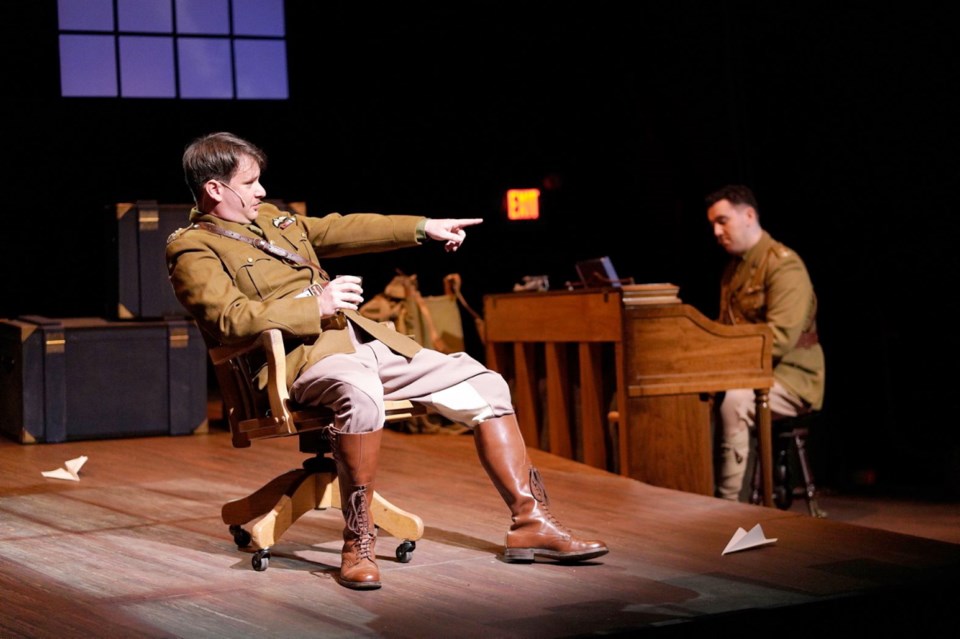There’s a reason Billy Bishop Goes to War (1978) is acknowledged as one of the great classics of Canadian theatre. While faithfully portraying flying ace Billy Bishop as a bona fide war hero, the musical drama’s creators also reveal Bishop as an fundamentally flawed man.
The warts-and-all treatment by dramatist John MacLachlan Gray and co-creator Eric Peterson (who originated the role of Bishop) bristles with a gritty irreverence that dates well and seems deeply Canadian. The deftly constructed play, replete with barroom-style songs, is a remarkable example of intimate storytelling and a must-see for any serious theatre lover.
Blue Bridge Repertory Theatre has just opened a credible and appropriately rambunctious version of Billy Bishop Goes to War. The two-man show stars the likable R.J. Peters as Bishop and also features Gabriel MacDonald, who sings and plays the piano.
Bishop was credited with 72 victories, the highest of any British or Canadian pilot in the First World War (some historians dispute the veracity of Bishop’s claims). Renowned for his sharp eye and hell-bent-for-leather flying style, it’s safe to say Bishop was an extraordinarily brave man. He returned from one patrol with 210 bullet holes in his plane. To acknowledge his status as an ace, his mechanic painted the nose of his aircraft blue.
Real-life heroism can be a messy and complicated thing. Gray and Peterson paint Billy as a tough guy from Owen Sound, a shrewd kid on the make. Bishop cheerfully explains how he was caught cheating on his Royal Military College exams. He describes himself as a “liar and a cheat”. Accident prone and a disaster academically, Bishop nonetheless possessed a street fighter’s determination and the laser-beam focus typical of those who excel.
As a cavalry man posted overseas, Billy decided the mud and hardship of trench warfare were not for him. The answer to his dilemma comes in a dream-like sequence that’s wonderfully portrayed. One day he sees a pilot waft down to Earth like a “dragon fly” to seek directions. The lost airman is clean and dry; he wears a leather cap, goggles and a warm sheepskin coat. Bishop knows instantly becoming a pilot will be his destiny.
Under the direction of Jacob Richmond, Peters — dressed in jodhpurs and a military jacket — makes Bishop an agreeable Everyman. On Wednesday night, the actor, navigating a sharply raked stage, radiated aw-shucks appeal, grinning as he related the misadventures leading to Bishop’s unlikely emergence as an airborne superstar.
Peters is well cast for the role, given the show’s intimacy and his ability to connect with an audience in an easy, affable manner. It’s true that, on this particular night, the actor sometimes tripped over lines; this will improve as the run progresses.
And it must be noted Billy Bishop is a monster of a role. As well as doing most of the heavy lifting, the actor playing Bishop portrays a multitude of other characters, such as Lady St. Helier (a friend of Churchill’s who helped Billy become a pilot), a French nightclub singer and a handful of Canadian and British military types. Peters handles this adeptly, although at times his impersonations of different accents were wobbly.
On this evening Peters’ most successful turn was his recitation of a poem about Albert Ball, the young British flying ace who died at age 20 (First World War fighter pilots lived frighteningly short lives). England embraced Ball as a hero, but the poem captures the futility and horror of a life truncated so young. Peters captured this beautifully in an emotionally charged performance that connected with the audience like a live wire.
Billy Bishop Goes to War is full of rollicking songs. Some provide an ironic counterpoint to the play’s action. One of these, repeated throughout the show, is We Were Off to Fight the Hun. In the beginning the song radiates a naïve optimism, yet as the horrors of war become apparent, it becomes a haunting refrain.
MacDonald is strong as Peters’ wingman, singing and playing an upright piano skillfully and handling small roles with aplomb. Sometimes the piano’s volume overshadowed the recitation of lines, a small but important thing that could easily be remedied.
Hans Saefkow has created a lovely functional set featuring such simple props as trunks, a vintage microphone, a desk and a lamp. In the background, through a triptych of hangar-style windows, we see spinning propellers, nightclub interiors, ornate gardens. When Bishop tells of his climactic solo attack on a German aerodome, black clouds churn furiously behind him.
Billy Bishop Goes to War continues at the Roxy Theatre to Nov. 4.



